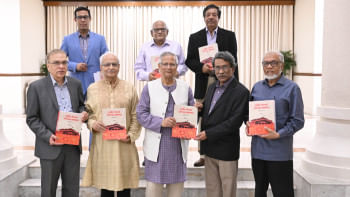Exports to US rise 10% in July-Sept. Will it continue?

- Exports to US rise despite Trump tariffs
- Garment shipments surge, driven by holiday demand
- Tariff cuts, China slowdown bolster Bangladesh trade
- Pharma, footwear exports expand amid shifting sourcing
Merchandise shipments to the United States rose by more than 10 percent year-on-year in the July-September quarter of the fiscal year 2025-26, defying concerns that the Trump tariffs would slow the country's trade with its largest export market.
Bangladesh earned $2.3 billion from exports to the US in the first quarter of FY26, up from $2.1 billion in the same period a year earlier, according to the Export Promotion Bureau (EPB).
Of this, ready-made garments accounted for $2.12 billion, compared with $1.87 billion last year.
The American market made up more than a fifth of Bangladesh's total garment exports, driven by strong demand from Western retailers stocking up ahead of the Christmas season.
This growth comes despite imposition of addition tariffs imposed by the Trump administration, which have made Bangladeshi goods more expensive than those from duty-free competitors.
The US had earlier reduced its reciprocal tariff rate for Bangladesh to 20 percent from the initial 37 percent after Bangladesh agreed to increase imports from the US to help narrow the annual trade gap of over $6.2 billion.The new rate came into effect in August.
"There is no possibility of export decline from Bangladesh to the US due to the new tariffs, as we mainly export low-value apparel products for hypermarkets," said Mohammad Hatem, president of the Bangladesh Knitwear Manufacturers and Exporters Association (BKMEA).
"The price increase from the tariff will be minimal and unlikely to affect demand," he added.
Hatem said as prices for high-end products rise with the new rates, more US consumers may turn to affordable options, boosting sales of Bangladeshi goods.
Many competitors do not have the capacity to produce low-cost garments, leaving Bangladesh well placed to meet demand in the coming months, he added.
Mohammad Abdur Razzaque, chairman of local think tank Research and Policy Integration for Development, said exports to the US have risen in the first quarter, with garment shipments up by more than 13 percent.
"The feared impact of the Trump-era tariffs has not materialised yet," Razzaque said, while noting it was still early to judge, as the tariffs only took effect in August.
He pointed to three factors supporting exports. Those include reduced American imports from China, concerns over India's supply reliability, and adjustments in Vietnam's China-dependent supply chain.
The real test, Razzaque said, will come in the next quarter. "By December or January next year, we will have a clearer view of how the US market is responding."
Razzaque said that without the tariffs, garment export growth could have reached 12 to 15 percent, helped by a global rebound in demand.
Bangladesh lost its preferential access to the US market in 2013 after the suspension of the Generalised System of Preferences over labour and safety issues. Since then, the garment industry has made major improvements in workplace safety and environmental standards, including setting up the highest number of green factories in the world.
Even so, apparel products remain excluded from the GSP scheme, a policy many in the sector describe as "unfair and outdated".
Riad Mahmud, managing director of N Poly, which exports non-leather shoes to the US, said orders have risen recently not because of new demand but due to strategic sourcing by buyers.
"We are now receiving orders we previously missed," he said, citing mid-range brands such as Fila and Decathlon.
Mahmud said tariffs on Chinese footwear have prompted US buyers to look for new suppliers, creating opportunities for Bangladeshi exporters. But he believes sustaining this growth would depend on meeting compliance standards such as Nirapon, which many factories struggle to afford.
Shawkat Haider, executive director of Beximco Pharmaceuticals, said pharmaceutical exports to the US are also growing despite concerns about the new tariff rates.
"Following the Trump tariffs, there were fears that our exports would decline. Some even projected a $1.2 billion drop. But the reality is quite the opposite; exports are increasing," he said.
Haider said the US has become Beximco's largest export destination.
The tariffs, he said, mainly target branded originator drugs from multinational companies, while generic medicines, which make up most of Bangladesh's pharmaceutical exports, are unaffected.
"Trump's policies have not had any negative impact on generics so far," he said, adding that Bangladesh was emerging as a strong alternative to China and India in the global pharmaceutical supply chain.

 For all latest news, follow The Daily Star's Google News channel.
For all latest news, follow The Daily Star's Google News channel. 



Comments